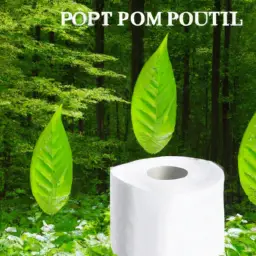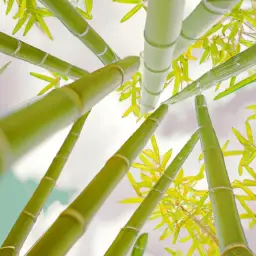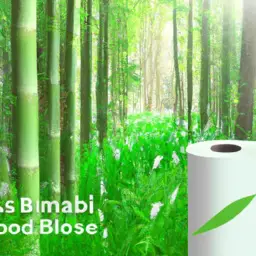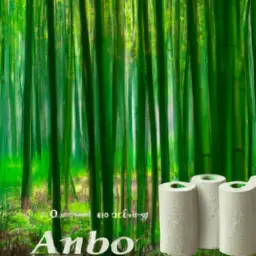Hey there!
I wanted to share my thoughts on a game-changing solution for toilet paper: bamboo! Traditional toilet paper takes a toll on the environment, but bamboo toilet paper offers a sustainable alternative.
In this article, I’ll dive into the benefits of using bamboo toilet paper and compare it to conventional options. It’s time to embrace nature’s solution and make the switch to a more eco-friendly bathroom essential.
Let’s explore the future of toilet paper together!
The Environmental Impact of Traditional Toilet Paper

In my opinion, the use of traditional toilet paper has a significant environmental impact due to the high demand for virgin tree pulp and the energy-intensive manufacturing process. This has spurred the need for alternative options that are more eco-friendly.
Thankfully, there are several eco-friendly alternatives to traditional toilet paper that can help reduce our environmental footprint.
One popular alternative is bamboo toilet paper. Bamboo is a fast-growing plant that requires minimal water and no pesticides, making it a sustainable option. It can be harvested without killing the plant, allowing for rapid regrowth.
Another option is recycled toilet paper, which is made from post-consumer waste paper. By using recycled materials, we can reduce the demand for virgin tree pulp and conserve valuable resources.
Furthermore, some companies have even come up with innovative solutions, such as toilet paper made from agricultural waste or organic cotton. These alternatives not only minimize the use of trees but also reduce the energy and water consumption associated with traditional toilet paper manufacturing processes.
Exploring Renewable Materials for Toilet Paper

As an advocate for sustainability, I believe it’s crucial to explore renewable materials for toilet paper production in order to reduce our reliance on finite resources. Traditional toilet paper is made from trees, which contributes to deforestation and loss of biodiversity. However, there are sustainable alternatives and eco-friendly options available that can help mitigate these environmental impacts.
One promising renewable material for toilet paper production is bamboo. Bamboo is a fast-growing plant that doesn’t require as much water or pesticides as trees. It can be harvested within a few years, making it a more sustainable option compared to traditional wood pulp. Additionally, bamboo has natural antimicrobial properties, which can help in maintaining hygiene.
Another renewable material that can be used for toilet paper production is recycled paper. By using post-consumer recycled paper, we can reduce the demand for virgin materials and minimize waste. Recycling paper also requires less energy and water compared to producing new paper from trees.
Moreover, there are innovative companies exploring alternative materials such as hemp and agricultural waste for toilet paper production. These materials have the potential to further reduce the environmental impact associated with traditional toilet paper production.
Bamboo: A Sustainable Solution for Toilet Paper

With its rapid growth and natural antimicrobial properties, bamboo is an ideal and sustainable option for toilet paper production.
Bamboo farming is a sustainable practice as it requires no pesticides or fertilizers due to bamboo’s natural resilience against pests and diseases. Bamboo also has a high growth rate, making it an abundant and renewable resource.
Unlike trees, which take years to mature, bamboo can reach full maturity in just three to five years, making it a more efficient option for toilet paper production. This quick growth rate also means that bamboo can be harvested more frequently, ensuring a steady supply of toilet paper without depleting natural resources.
Additionally, bamboo has natural antimicrobial properties, which make it a hygienic choice for toilet paper. These properties help to inhibit the growth of bacteria and fungi, reducing the risk of contamination.
The Benefits of Using Bamboo Toilet Paper

Using bamboo toilet paper offers numerous benefits, including its sustainability, softness, and eco-friendliness. Bamboo is a highly renewable resource that grows quickly, making it an environmentally friendly alternative to traditional toilet paper made from trees. It is also biodegradable, meaning it can break down naturally without causing harm to the environment.
Not only is bamboo toilet paper eco-friendly, but it is also soft and strong. The natural fibers of bamboo make it gentle on the skin, providing a comfortable and pleasant experience. Additionally, bamboo fibers are naturally strong, which means you don’t have to sacrifice durability for sustainability.
To highlight the benefits of bamboo toilet paper, take a look at the table below:
| Benefits of Bamboo Toilet Paper | ||
|---|---|---|
| Eco-Friendly | Soft | Strong |
| Made from a renewable resource | Gentle on the skin | Durable |
| Biodegradable | Comfortable to use | Reliable |
The Process of Making Bamboo Toilet Paper

From harvesting to manufacturing, I’m amazed by the intricate process of turning bamboo into toilet paper.
The first step in the bamboo toilet paper manufacturing process is making bamboo pulp. This involves extracting the fibers from the bamboo stalks and breaking them down into a pulp consistency. The bamboo stalks are first cut into small pieces and then soaked in a mixture of water and chemicals to remove impurities. After soaking, the bamboo is mechanically processed to separate the fibers from the rest of the plant material. Once the bamboo pulp is obtained, it’s further processed to remove excess water and create a smooth and even texture.
After the bamboo pulp is ready, it’s then used to make the actual toilet paper. The pulp is mixed with water and other additives to enhance softness and strength. This mixture is then spread onto a large mesh screen and pressed to remove excess water. The wet sheet of bamboo pulp is then dried and smoothed before being rolled onto large spools.
The final step in the process is cutting the rolls into individual toilet paper sheets and packaging them for distribution. The manufacturing process ensures that the bamboo toilet paper is soft, strong, and environmentally friendly. It’s truly fascinating to see how bamboo, a sustainable and fast-growing plant, can be transformed into a product that we use every day.
Comparing Bamboo Toilet Paper to Conventional Options

I prefer bamboo toilet paper over conventional options because it’s both sustainable and soft. When it comes to environmental benefits, bamboo toilet paper stands out. Bamboo is a highly renewable resource that grows rapidly, making it a sustainable choice for toilet paper production. Unlike traditional toilet paper, which is made from trees that take years to grow, bamboo can be harvested in just a few months. This means that bamboo toilet paper has a significantly lower impact on deforestation and habitat destruction.
In terms of cost comparison, bamboo toilet paper may seem more expensive upfront. However, when you consider the long-term benefits, it becomes a cost-effective option. Bamboo toilet paper is stronger and more absorbent than conventional toilet paper, which means you’ll need less of it per use. This can result in saving money in the long run.
Additionally, bamboo toilet paper is softer and gentler on the skin. It provides a luxurious and comfortable experience while still being durable and effective. Conventional toilet paper often contains harsh chemicals and dyes that can irritate sensitive skin, making bamboo toilet paper a better choice for those with skin sensitivities.
Embracing Nature’s Solution: Switching to Bamboo Toilet Paper

To fully embrace nature’s solution, I’ll switch to using bamboo toilet paper. Not only does bamboo toilet paper offer numerous environmental benefits, but it also meets the growing consumer demand for sustainable products.
One of the key environmental benefits of bamboo toilet paper is its sustainability. Unlike traditional toilet paper made from trees, bamboo is a rapidly renewable resource that can be harvested within three to five years. This means that bamboo can be replenished much faster than trees, reducing deforestation and preserving natural habitats.
Another advantage of bamboo toilet paper is its low carbon footprint. Bamboo plants absorb more carbon dioxide and release more oxygen compared to trees, making it a more environmentally friendly option. Additionally, bamboo requires less water and fewer pesticides to grow, further reducing its impact on the environment.
Furthermore, consumer demand for sustainable products is on the rise. People are becoming more conscious of the environmental impact of their choices and are actively seeking eco-friendly alternatives. By switching to bamboo toilet paper, I can contribute to this demand and make a positive impact on the planet.
Conclusion
In conclusion, bamboo toilet paper offers a sustainable solution to the environmental impact caused by traditional options.
By embracing nature’s solution and switching to bamboo toilet paper, we can reduce deforestation and minimize our carbon footprint.
Not only is bamboo toilet paper eco-friendly, but it’s also softer and stronger than conventional alternatives.
Making this simple switch can make a big difference in preserving our planet for future generations.

